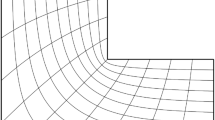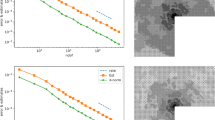Abstract
In order to calculate accurate physical values of interior region by the boundary element method, a new approach is proposed to singular kernel integration which is applicable to general isoparametric elements and never fails, no matter where the internal point under consideration may be located. The integration scheme consists of two parts.
First, the singular kernel functions are assumed to be “reciprocal of the distance” types. Then the present scheme describes on the quadrate boundary element. The element is subdivided into four triangular regions for which Gauss-Legendre numerical quadrature is applied.
Secondly, a method is proposed to reduce residual errors in the application of the above mentioned numerical scheme. The boundary integrals to calculate interior physical values are expressed formally with exact and numerical error terms, and boundary values in error terms are expanded by a Taylor series around the interior point. To evaluate the coefficient of each derivative in the series, a boundary integral form of an identity with respect to a vector from the interior point to the boundary surface is derived. Error resulting from numerical integration of the identity is found to coincide with the coefficient of the derivative in the Taylor series. Thus, the correction factor for numerical errors is obtained.
The present scheme was verified to be quite effective such that both the numerical error and CPU time became 1/100 less than those by the double exponential quadrature. Moreover, the present numerical scheme is applicable to general curved elements.
Similar content being viewed by others
References
Cox, J. V.; Shugar, T. A. (1985): A recursive integration technique for boundary element method in elastostatics, advanced topics in boundary element analysis. AMD—Vol. 72. The winter meeting of ASME
Enokizono et al. (1986): Boundary element analysis using revised integration. Electr. Eng. in Japan 106 3, 42–50
Higashimachi, T. et al. (1983): Interactive structure analysis system using the advanced boundary element method. Boundary Elements Proceeding of 5th Int. Conf. pp. 847–856. Berlin, Heidelberg, New York: Springer
Koizumi, M.; Utamura, M. (1986): A new approach to singular kernel integration for general curved elements. Boundary Elements Proceeding of 8th Int. Conf., pp. 665–675. Berlin, Heidelberg, New York: Springer
Kuwabara, T.; Takeda, T. (1985): Calculation of potential and potential gradient for 3-dimensional field by B.E.M. using analytical integration. pp. 73 to 82 Proceeding of Conf. on Rotary Machines and Stational Apparatus, SA-85-47, JECM. pp. 73 to 82
Rizzo, F. J.; Shippy, D. J. (1977): An advanced boundary integration method for three-dimensional thermoelasticity. Int. J. Numer. Meth. Eng. 1753–1768
Takahashi, K. et al. (1985): On the evaluation of various numerical integrations in boundary element method, pp. 91–99. Proceeding of Conf. on Rotary Machines and Stational Apparatus, SA-84-49, JEC pp. 91 to 99
Utamura, M.; Koizumi, M. (1985): Development of computer program for analyzing three-dimensional pressure field in pressure suppression system. J. Nucl. Sci. Technol. 22, 733–741
Author information
Authors and Affiliations
Additional information
Communicated by S. N. Atluri, December 8, 1989
Rights and permissions
About this article
Cite this article
Koizumi, M., Utamura, M. A polar coordinate integration scheme with a hierachical correction procedure to improve numerical accuracy on the boundary element method. Computational Mechanics 7, 183–194 (1991). https://doi.org/10.1007/BF00369978
Issue Date:
DOI: https://doi.org/10.1007/BF00369978




